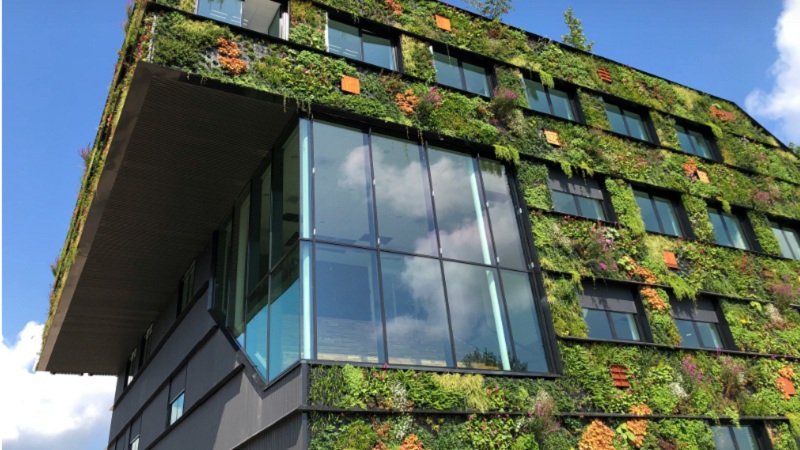India is experiencing a dramatic rise in temperatures. Each year, new temperature records are set, with 554 heatwave days from 2022 to 2024, while air pollution intensifies and green spaces in cities shrink. From Delhi to Chennai, rising temperatures are no longer just a discomfort—they represent a growing climate emergency that affects public health, productivity, and overall quality of life.
At the core of this crisis lies the Urban Heat Island (UHI) effect, where urban areas become significantly hotter than their rural surroundings due to concrete, asphalt, and other heat-retaining materials. Added to this is the heat from traffic, industry, and buildings, turning our cities into concrete ovens.
But what if these very city surfaces could become part of the solution?
Roofs and walls—often overlooked—hold massive potential for climate action. Much of the heat that enters buildings does so through the envelope: roofs, walls, and windows. This leads to higher energy use for air-conditioning, spiking bills and, in turn, emissions from elevated energy generation.
While traditional solutions like insulation and reflective paints help, they serve a single purpose: reducing heat gain. What we now need are solutions that do more—with less.
Greening the envelope
Enter green roofs and vertical gardens—nature-based systems that transform static surfaces into living ecosystems. These systems go beyond temperature control: they cool, purify, beautify, and help restore urban ecosystems. Green roofs—whether lightweight extensive covers or deeper, garden-style intensive setups—act as natural insulators, lowering indoor temperatures and reducing stormwater runoff. Vertical gardens, using climbers or modular hydroponic panels, cool the air, trap dust, cut noise, and even boost mental wellbeing.
Through evapotranspiration—the process of water moving from the earth’s surface to the atmosphere—and shading, green roofs can reduce indoor temperatures by up to 20°C in some cases. Vegetation absorbs sunlight, transpires water, and cools the air. Certain systems reflect 27 percent of solar radiation, absorb 60 percent, and transmit minimal heat—making them a potent tool in heat-stressed cities.
Studies show they can reduce air-conditioning needs by 20–80 percent, depending on climate, plant type, and surface coverage. The benefits go beyond cooling. These systems clean the air via photosynthesis, offer habitats to birds and insects, and improve acoustic insulation. They also protect building envelopes from sun, wind, and rain, extending their lifespan.
Getting the green right
However, these aren’t plug-and-play solutions. Proper design and structural assessment are essential, particularly for load-bearing capacity of buildings, especially older ones. Green systems add weight—soil, plants, and irrigation infrastructure—so safety must come first. Water management is also critical as poor drainage can lead to leaks, mold, and damage, especially during monsoons. Automated irrigation systems provide relief and help maintain moisture levels efficiently, reducing chances of damage.
Plant selection matters too. Native, drought-tolerant species thrive with less care and support local biodiversity. Details like leaf area index (LAI) and canopy density influence shading, cooling, and even air purification. Though low-tech in spirit, these systems demand technical precision and ongoing care. Maintenance is non-negotiable: from pruning to checking irrigation lines, green infrastructure requires stewardship. It’s not a “set and forget” fix—it’s a living layer.
Green infrastructure also brings jobs. Horticulturists, system designers, installers, and maintenance professionals are in growing demand. With the right support, this could evolve into a vibrant urban green jobs sector. Community-led efforts play a powerful role as well, with RWAs, NGOs, and school projects needing to reclaim rooftops and walls, one surface at a time. These grassroots actions create not just greener cities, but stronger, more resilient communities, forcing administration to take interest.
For a true grey-to-green transformation, green infrastructure must be woven into the urban development fabric. That means revising building byelaws, integrating vegetative coverings into public infrastructure design, and offering design flexibility for retrofits.
One of the biggest opportunities lies in retrofitting existing buildings. Unlike many climate solutions that need new land or major redevelopment, retrofitting involves adding features like green roofs and vertical gardens to existing structures—making them ideal for India’s densely populated cities. This approach offers a practical pathway to green entire neighborhoods without the need for large-scale redevelopment. Moreover it is a scalable, low-footprint strategy, improving comfort, cutting energy use, and enhancing aesthetics and property value.
Despite its clear advantages, green roofs and vertical gardens remain rare in Indian cities. While the Smart Cities Mission and Atal Mission for Rejuvenation and Urban Transformation (AMRUT) have piloted some projects, broader adoption has been slow. A key barrier remains the lack of policy support, technical guidance, and financial incentives.
Public-private partnerships can unlock funding and academia can provide support through research and skill development. Institutions such as The Energy and Resources Institute (TERI) and GRIHA have already been at the forefront of promoting green roofs and vertical gardens in India.
TERI, in collaboration with the Smart Surfaces Coalition (USA), has developed a decision-support tool to help city administrations identify the most suitable smart surface solutions—including green roofs and vertical gardens—based on cost-benefit analysis and local context. This tool empowers urban planners to make informed, city-scale interventions.
Additionally, the GRIHA rating system incentivises the adoption of green roofs and walls by awarding recognition points, thereby raising awareness among stakeholders. GRIHA has also released a comprehensive list of climate-specific native plant species for India, offering practical guidance for regionally appropriate green infrastructure design.
Green roof and wall systems are climate solutions and community assets, not luxury features. Raising public awareness is crucial to not be viewed as elite frills but as essential infrastructure. Design competitions, awareness campaigns, and community involvement is a necessity to shift perception and create demand.
The canopy ahead
India’s climate clock is ticking. Heatwaves are not mere summer nuisances—they’re public health threats. As our cities grow, they must become smarter, cooler, and greener. Green roofs and vertical gardens are not silver bullets—they’re powerful, proven, and practical.
The shift from concrete to canopy is not merely aesthetic or environmental—it is a matter of survival, equity, and quality of life. The time to act is now with more than pilot projects. We need policy, partnerships, and public will. If we want resilient, breathable cities, we must start planting the change—right on our walls and rooftops.
Shabnam Bassi is Director, Sustainable Buildings Division, TERI and Deputy CEO cum Secretary for GRIHA council, Sheen Pandita is a Research Associate in the Sustainable Buildings Division, TERI.
Originally published under Creative Commons by 360info™.















